Rethinking CAD Viewers
Market pressures are leading developers of traditional view and markup software to streamline programs and beef up collaboration features.
Latest News
June 25, 2007
By Nancy Rouse-Talley
The past few years have forever changed the world of view and markup. Previously, engineers who needed to share MCAD data with the larger organization used specialized viewers that were often expensive. However, free viewers for specific MCAD programs as well as the introduction of Acrobat 3D from Adobe Systems have changed the product landscape for engineers as well as the companies that provide traditional viewers.
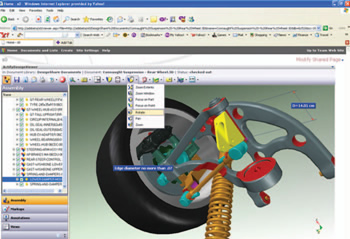 Actify’s DesignShare provides a way for manufacturing personnel and others to access design data without having to use a full-fledged PLM system.The system is based on Microsoft’s SharePoint platform and uses Actify’s SpinFire viewer,which saves MCAD data in the company’s proprietary .3D format. |
Acrobat 3D allows users to embed 3D models in PDF documents, giving anyone who receives the PDF the means to manipulate the MCAD data, create exploded views, and look at geometry from different angles. The first release of the program left something to be desired in its ability to read MCAD data. Models had to be translated into a format called U3D, and most MCAD programs did not output to that format. However, the latest version of the software, 8.0, uses 3D MCAD translators from Trade and Technologies France (TTF), acquired by Adobe last year, which can read models from most common CAD and MCAD programs including AutoCAD, CATIA (V4 and V5), I-DEAS, Inventor, Pro/Engineer, and SolidWorks.
Adobe also improved the dimensional accuracy of its models in Version 8.0. Now the software maintains surface models, or boundary representations, of many CAD formats. B-reps are more accurate than Acrobat 3D’s tessellated, mesh-format U3D models, and can be output as STEP, IGES, or Parasolid files for use in manufacturing applications. Plus, Acrobat 3D allows users to annotate the PDF.
The most obvious use of Acrobat 3D is in the production of technical documentation. The program makes it easy to convert files containing multiple formats (such as Word documents with embedded 3D models) into PDFs for publication and distribution. Less certain is whether the MCAD translation capabilities will work well enough to be useful for manufacturing applications. Converting CAD files to IGES and other manufacturing formats while maintaining accuracy is both art and science, and the actual usefulness of a particular converter often cannot be determined without extensive testing.
Cimmetry Highlights Electronics
Some might think that the availability of inexpensive 3D viewers such as Acrobat 3D, which retails for $995, as well as free viewers for mid-range MCAD programs such as Inventor, Solid Edge, and SolidWorks, would render traditional viewer applications such as AutoVue (see “Design Collaboration Made Easy,” DE November 2006) from Cimmetry Systems irrelevant. However, visualization software such as AutoVue offers a range of features in addition to the ability to view and mark up files.
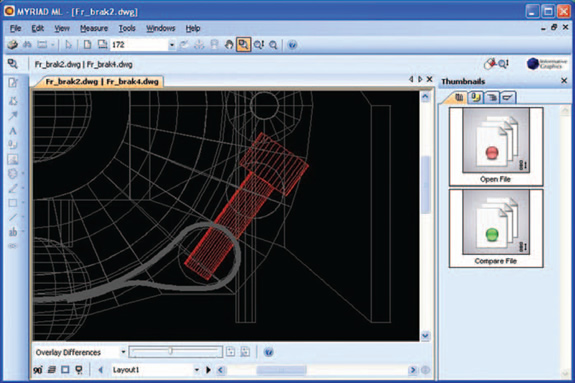 The newest versions of Informative Graphics’Myriad, Brava Desktop, and Brava Enterprise have the ability to compare two files, highlighting missing geometry in red. |
For example, AutoVue is adept at combining mechanical and electronic CAD formats into a holistic product-design view that can be reviewed and annotated. An advantage of Cimmetry’s solution over other viewing software, and one that cannot be overemphasized, is the fact that AutoVue actually lets users view the native eCAD or MCAD file rather than convert it to other formats such as Adobe’s U3D. This approach maintains the accuracy of the design data. Plus, AutoVue users have access to the descriptive data associated with the geometry.
Cimmetry’s most recent version, AutoVue 19.2, was scheduled for release in late June, about the time this issue was mailed, and extends its capabilities to view and markup of electronic design automation (EDA) files. Cimmetry honed its EDA features based on feedback from users. For example, it has made changes in the program’s ability to manage the layers of printed-circuit boards. Now AutoVue can manipulate the actual physical layers of boards in addition to the logical layers. Using this capability, engineers looking at board views can turn on and off the pin, via, and trace components on physical layers.
AutoVue added a feature called Browse Tips to its software that allows the user to hover over a component and see its most useful attributes. For instance, users can see the net and pad stack location of pins as well as the net, width, and layer of traces. This feature speeds up design review by eliminating the need to actually double-click on a component to bring up data.
Cimmetry has improved its ability to navigate between a board layout, its related schematic, and 3D models. Using the cross-probe feature of AutoVue 19.2, the user can find all occurrences of a particular component or net within various files. In addition, the software now offers an automatic mode that determines the appropriate view (layout, schematic, 3D model) for the cross-probe target.
As an alternative to highlighting, a toolbar button allows the user to dim the areas surrounding components on board layouts. Users can also bring up the board-layer sets as they were created in the design software, including colors, thereby eliminating the need to recreate them for viewing. And AutoVue lets users search for any electrical entity (pins, nets, vias, etc.) across all pages of a particular schematic.
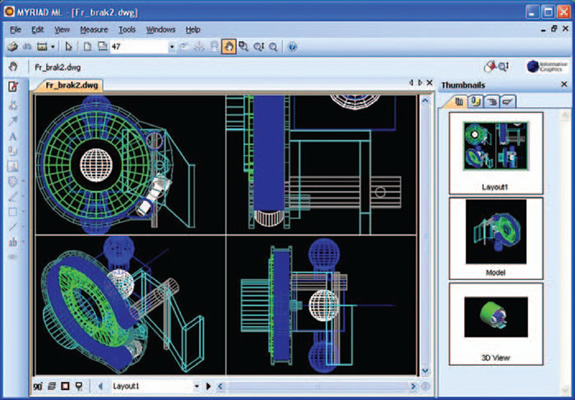 All Informative Graphics’programs now have a consistent user interface, including a right-hand pane to display thumbnails,model hierarchies, and other features of your MCAD data. |
Small touches separate AutoVue from other viewing and markup tools. Version 19.2, for example, allows users to put an arrow on a line to pinpoint the location being referenced in a comment. Users can hover over the comment to see who made it and when. They can also choose to hide specific comments and can sort on the feature tree by author, date, and entity type.
Finally, Cimmetry recently released AutoVue 3D Pro–SME for users who want a lower-cost visualization solution for looking at and marking up files from mid-range CAD systems such as Inventor, SolidWorks, and Solid Edge. AutoVue 3D Pro-SME provides all the features of the full version of AutoVue, but with fewer file formats. A single-user license of 3D Pro-SME is $948, and the software can be upgraded to view high-end CAD systems, such as CATIA, NX, or Pro/Engineer. Configurations of AutoVue 19.2 range between $474 to $1794, depending on the functions and formats required. Prices include first-year maintenance.
Informative Graphics Refocuses
In the past, privately held Informative Graphics (IG) offered a dizzying array of free and paid graphics viewers and markup software. Recently, the company has been paring back and consolidating its product lines. It spun off its Project Dox online collaboration product, a competitor with products such as Autodesk’s Buzzsaw, to a separate company called Avolve Software. It also has retired its ModelPress 3D viewing software, which allowed users to view 3D models in Informative Graphic’s proprietary 3DF format.
Why the changes? According to IG Marketing Manager Christine Musil, Project Dox was spun off because the product competed for resources the company thought would be better devoted to building and strengthening its Myriad and Brava viewing and markup programs. In addition, the company found its users were not particularly interested in a 3D viewer.
The differences between the two products are notable more for where they are used than for the particular viewing and markup features of each. Brava, available in Web-based enterprise as well as desktop versions, serves the financial, insurance, legal, construction, life sciences, government, and manufacturing markets where it is used in conjunction with document management products such as EMC Documentum, Open Text, Microsoft SharePoint/Infopath, Interwoven, Meridian Project Systems, and Primavera. In Brava, users can look at and mark up native 2D CAD files and other document and image formats. It offers a unique feature called redaction, which allows users to black out sensitive information such as account numbers.
The Myriad product handles engineering and manufacturing-floor applications, reading most 2D CAD and 3D MCAD formats and supporting a wide range of additional graphics and document formats such as VRML (virtual reality modeling language), Autodesk’s 3D DWF, STL (standard tessellation language), PDF, and Microsoft Office.
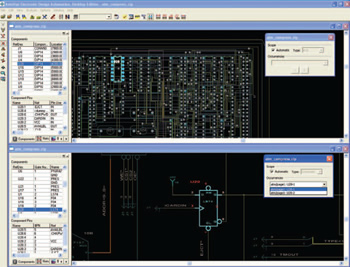 Cimmetry’s AutoVue allows users to cross-probe between board layouts, schematics, and 3D models to find all instances of a particular component or net. |
Informative Graphics changed the Compare feature of the product to make it easier to see where changes were made. Instead of just overlaying two views on top of each other, users can fade either image to see exactly where changes were made. Users also see changes as green or red, indicating additions and subtractions, respectively. These changes make it easier to see subtle changes in files.
The new Myriad offers a right-hand side pane for displaying both 2D and 3D data. Anything affecting the view of the file is generally listed there, including the 3D parts list, cut/cross-section controls, thumbnails, and notes. Myriad also offers a free 3D viewer that replaces the old ModelPress reader for looking at STL, VRML, 3D DWF, and secure 3DF formats. It also allows users to rotate and take measurements on models, do cross-sections, and prepare exploded views.
Visual Data Management
Viewers usually do not provide ways to effectively share files, but Actify is building products around its viewer that allow people to manage, share, and collaborate on documents. The company’s DesignShare file-management software allows workgroups to use MCAD data as well as manage related documents. DesignShare works on top of Microsoft SharePoint portal software.
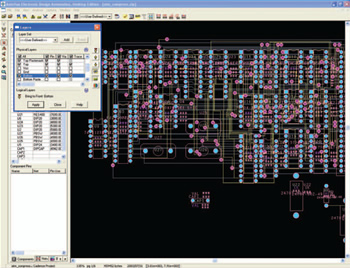 Engineers using AutoVue can turn on and off the pin, via, and trace components on physical layers of PCB boards in addition to manipulating the logical layers. |
Although the basic description of DesignShare sounds like PLM, Actify claims that the product complements traditional PLM systems, such as SmarTeam, that manage design data for workgroups. According to Actify’s president, David Opsahl, DesignShare makes design information available to people outside the engineering department who need to work with the MCAD data, while keeping the data synchronous.
“Typically, an engineer would set up a workflow that triggers the PLM system to publish a file to a SharePoint document library. The people who need to use the information are notified by SharePoint that it is available to them,” said Opsahl. “They do not have to look for it in the PLM system. DesignShare can also employ SharePoint capabilities for versioning.”
A major benefit of SharePoint is its transparent integration with Microsoft Office. Actify provides a plug-in for Office that allows users to use 3D MCAD data (in Actify’s .3D format) in Office applications. For example, Actify’s plug-in lets users manipulate models in PowerPoint slides. Users also can use the plug-in to link calculations in Excel spreadsheets directly to values in the MCAD file. In addition, Actify implements its Publisher software in DesignShare to batch publish native 2D and 3D files.
The Future
Although new product entries from companies such as Adobe have made the market for engineering visualization more competitive, the new rivalries seem to have reinvigorated traditional viewer vendors. They are building better and more competitively priced 3D viewers, refocusing market efforts, and adding collaboration features that make it easier to share design data.
Actify, Inc.
San Francisco, CA
actify.com
Adobe Systems, Inc.
San Jose, CA
adobe.com
Cimmetry Systems
Montreal, Quebec, Canada
cimmetry.com
Informative Graphics
Scottsdale, AZ
infograph.com
Nancy Rouse-Talley is a freelance writer who focuses on technology subjects, including product lifecycle management, computer-aided design, and engineering. You can send Rouse-Talley your thoughts on this article c/o [email protected].
Subscribe to our FREE magazine, FREE email newsletters or both!
Latest News
About the Author
DE’s editors contribute news and new product announcements to Digital Engineering.
Press releases may be sent to them via [email protected].






